By John Duncan, Telluride Angler
The Fishing | Sector Model Reviews | More Equipment Observations
In December, my partners and I flew south for a week to field test Scott Sector fly rods on the Atlantic coast of Mexico. This was our first opportunity to actually fish a breadth of the new models for permit and bonefish. It was also the first time all four of us have fished together at a saltwater destination. It would have been epic even without the permit. The anglers were myself, Tom Craddock, Troy Youngfleish and Kris Knackendoffel.
South from Cancun, Mexico’s easternmost highway passes through a godless corridor of strip malls and tourist attractions, including representative swim-with-the-dolphin and feed-the-crocodile enterprises. Gated resorts are shielded by hedges and pines planted in tight rows. The resorts front the open Atlantic, but the view from the highway varies little. Smoke tendrils rise from slash piles. Coke bottles on sticks mark paths into the undergrowth where Mayan families make their homes. Civilization thins beyond Tulum, the way passing through unspoiled pueblos with weathered cathedrals, authentic street food stalls and the occasional Pemex station to sustain the journey. Descending into the southern Yucatan, the driving corridor narrows as palms, pines and red mangrove press into the lanes. Hours beyond the last resort and 60 miles from gas or ice, the pavement turns to dirt in a remote village with an acutely foreign name, a place where understated tourism plays a modernizing role in a subsistence economy. The village claims between 300 and 700 native residents, a handful of ex-patriots, zero offshore fishing vessels and one of the most prolific inshore sport fisheries in the world. Bordered by water on three sides, a beach road winds north from town about 10 miles, ending at a jungle creek where the cement pilons of a former bridge stand in ruin. Along this road we reached our guest house, a concrete structure painted in bright colors facing the ocean and sunrise.
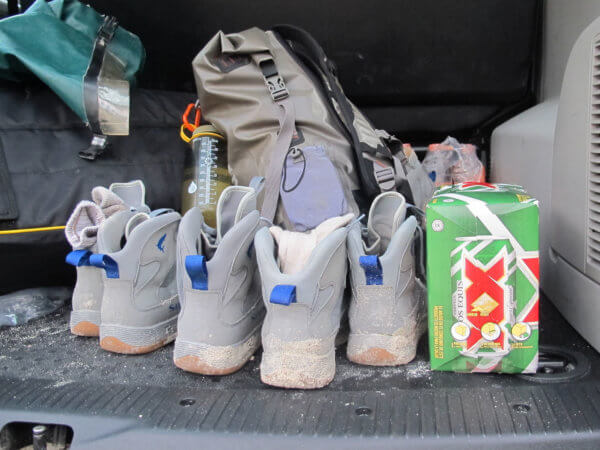 Our rental van was loaded with survival necessities: throw-away coolers filled with ice, 2 pounds of ground coffee, ingredients for 7 nights of fajitas and several hundred Mexican beers. We unpacked and settled in for the week. Most critical were the Scott Sector fly rods with carefully selected reels and lines for our permit and bonefishing. So soon after the rod’s release, Sectors were still hard to come by. With the help of Scott Rod Designer Jim Bartschi, we assembled an arsenal of the lighter line weights to field test: Sector 907-4, 848-4, 909-4 (3 of these), 8410-4 and 9010-4. Each of these was paired with a favorite reel, including Tibor Everglades, Hatch Finatics and several Nautilus NVGs. Lines were carefully chosen to match each rod based upon our prior casting experience. On the lighter rods we mostly fished Rio DirectCore Bonefish lines. On the 10-weights we had Rio DirectCore Permit lines and on the 9s we had some of each.
Our rental van was loaded with survival necessities: throw-away coolers filled with ice, 2 pounds of ground coffee, ingredients for 7 nights of fajitas and several hundred Mexican beers. We unpacked and settled in for the week. Most critical were the Scott Sector fly rods with carefully selected reels and lines for our permit and bonefishing. So soon after the rod’s release, Sectors were still hard to come by. With the help of Scott Rod Designer Jim Bartschi, we assembled an arsenal of the lighter line weights to field test: Sector 907-4, 848-4, 909-4 (3 of these), 8410-4 and 9010-4. Each of these was paired with a favorite reel, including Tibor Everglades, Hatch Finatics and several Nautilus NVGs. Lines were carefully chosen to match each rod based upon our prior casting experience. On the lighter rods we mostly fished Rio DirectCore Bonefish lines. On the 10-weights we had Rio DirectCore Permit lines and on the 9s we had some of each.
Over the course of the next week, we fished 2 days with guides from pangas and 4 days DIY, walking the ocean points and coves, searching for permit. We encountered permit every time we stepped out of the house. Some materialized in schools without warning, flashing their black tails in squadrons as they rode the rising tide onto rocky, wave-washed points. Others hid in plain sight, seemingly asleep in the shallows, their dorsal fins swaying calmly as the fish lolled from side to side dining on crabs and shrimp. These permit we encountered on foot, often early or late in the day. Our shots at these fish tested our nerves, but not the capability of the fly rods. In calm conditions we often cast to fish at only 25-30 feet, a chip shot with a trout rod let alone the finest casting saltwater sticks. In other cases, we cast at wakes as heavy fish prowled deep water flats in early morning light. Some of these permit became visible as they passed the panga, their deep sides and broad gill plates catching the sun’s first rays. Every day, each one of us cast to permit in many different scenarios: wading shallow, wading deep, upwind from the panga, across wind at distance. We fished mostly shrimp patterns, but with a wide range of size and weight. The shots varied tremendously, all urgent. We made some bad casts with very good fly rods, but more often than not, the Scott Sectors helped frenetic fisherman makes shots that had a real chance. On several occasions, the permit sealed the deal.
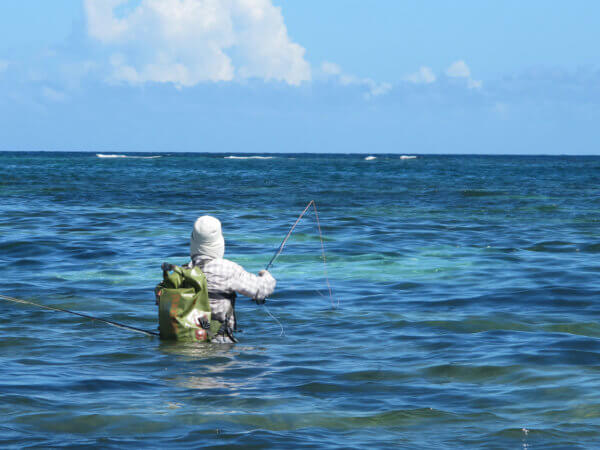 On the first day, we all came out of the house with 9’ 9-weights or 9’ 10-weights, traditional choices for permit. These were rigged with 9’ 20lbs leaders and either shrimp or crab patterns. We waded with the determination of anglers who hoped to find a fish or two over the course of the week, covering many miles of beach, flat and corral outcrop. Miraculously, we saw not one but perhaps 30 fish on our very first walk. We encountered a group on the windward side of a promising point, a half dozen fish born on a swell just beneath the surface. They bounced off the point almost at rod’s length, swung a hundred feet out into the bay, then turned, working directly toward us. We were standing so close together that Troy and I had to kneel in the waves so Kris could cast. On “You go!” Kris swung the rod twice, laid down his shrimp, stripped once and hooked a permit. Just like that. I couldn’t believe what I had just seen. As the fish peeled off line, I fumbled for my GoPro, a turkey sandwich dangling from my mouth. Kris caught and released the fish.
On the first day, we all came out of the house with 9’ 9-weights or 9’ 10-weights, traditional choices for permit. These were rigged with 9’ 20lbs leaders and either shrimp or crab patterns. We waded with the determination of anglers who hoped to find a fish or two over the course of the week, covering many miles of beach, flat and corral outcrop. Miraculously, we saw not one but perhaps 30 fish on our very first walk. We encountered a group on the windward side of a promising point, a half dozen fish born on a swell just beneath the surface. They bounced off the point almost at rod’s length, swung a hundred feet out into the bay, then turned, working directly toward us. We were standing so close together that Troy and I had to kneel in the waves so Kris could cast. On “You go!” Kris swung the rod twice, laid down his shrimp, stripped once and hooked a permit. Just like that. I couldn’t believe what I had just seen. As the fish peeled off line, I fumbled for my GoPro, a turkey sandwich dangling from my mouth. Kris caught and released the fish.
Near the end of our long walk home, we were surprised by several permit feeding on white sand just feet from the beach. We snapped into fishing mode with two of us wading the outside edge and the other two standing above water’s edge for the best view angle. Ten fish lapped the zone over the next hour. We hooked none but had countless great shots in a 200 yard stretch just south from a private pier, the owners of which, Frank and Sherry, being the friendliest people in Mexico. Dubbed “Frank and Sherry’s Permit Café,” we would visit this flat every afternoon throughout the week. We never landed a fish at “The Café,” but one evening I broke off a permit in comical fashion. Three fish swam right to my feet in the dying light of early evening. I stood still as a post for fear of spooking them. They moved past me on the left, slowly. Rod in my right hand, I swung and stopped the rod hard on my left shoulder, so the mantis shrimp plopped down behind me somewhere out of sight, no more than 15’ beyond the rod tip. One of the fish picked up the fly and headed for Africa. It was a crazy feeling, the line tugging vigorously while my eyes were averted. I spun around and immediately noticed my running line was looped once over the fighting butt. No worries. I had 60 feet of line stripped out and several seconds to react. I flipped the line off the fighting butt and waited for the moment of engagement when a rapidly departing fish hits the reel. Instead, my rod bucked violently, popping the 20lbs test. The loop of line I had thrown off the fighting butt had swung underneath and snagged precisely on the reel’s handle. Unbelievable. I can still hear my saltwater captain friends harping, “Never let go of the line with your left hand. Shoot it out through a circle formed by your forefinger and thumb.” Yes, good idea.

Over 4 days of DIY wading, we cast at permit in every imaginable scenario: long and short, in wind and dead calm, with dry feet from the beach and standing armpit deep, with large flies and small. In addition to permit, we caught bonefish, snapper and one hefty jack crevalle on the flat. We learned early that the bonefish would eat a permit fly on 20lbs tippet without hesitation, so we abandoned the idea of carrying a 2nd, lighter rod for bones.
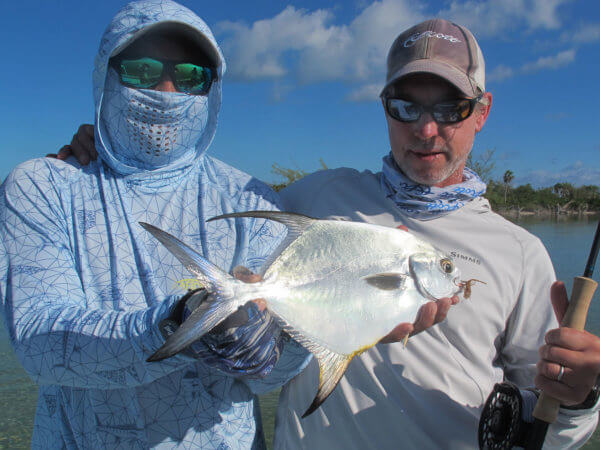 Of course, pangas offer the luxury of space. The two days spent with our hard-working guides were a study in excess. We rode the morning waves in comfort, pangas being the “BarcaLoungers” of flats fishing. At least 4 rods were rigged on each boat. We had ice for our beer. We had rare guides who actually polled the heavy pangas all day long. We brought turkey sandwiches but didn’t eat them because our guides provided homemade street tacos with a secret habanero sauce. At times, permit surrounded our boats. At others, we searched many flats but couldn’t find them. We caught 2 permit with our guides as well as some very respectable bonefish, at which we cast only when permit were nowhere on the radar.
Of course, pangas offer the luxury of space. The two days spent with our hard-working guides were a study in excess. We rode the morning waves in comfort, pangas being the “BarcaLoungers” of flats fishing. At least 4 rods were rigged on each boat. We had ice for our beer. We had rare guides who actually polled the heavy pangas all day long. We brought turkey sandwiches but didn’t eat them because our guides provided homemade street tacos with a secret habanero sauce. At times, permit surrounded our boats. At others, we searched many flats but couldn’t find them. We caught 2 permit with our guides as well as some very respectable bonefish, at which we cast only when permit were nowhere on the radar.
Casting from the boats, we used both the Sector 848-4 and Sector 8410-4 in addition to the 9’ models. They cast like a dream. It’s amazing how light and crisp these rods feel. Everything just happens faster and feels more intuitive. For permit fishing, we recommend these strictly as “boat rods,” however, because their shorter length is a distinct liability when wading deep. Most bonefish anglers would fish a Sector 848-4 without hesitation, wading tends to be much shallower.
Scott Sector Observations
- The 9’ rods had a big advantage when wading more than 12” deep. We frequently cast to fish while standing waist deep or more. It was hard to hold the line above the water while casting 8’4” rods in these situations.
- On the lawn, Rio’s Directcore Bonefish line is the sweetest pairing with a Scott Sector. When wading deep on the flat, however, it is not always possible to make lots of false casts and aerialize a long line. Short headed lines, such as the Grand Slam and Chard tapers, are really useful in these scenarios. The Sector casts these lines with ease, so if you prefer more of a shooting style line, go right ahead.
- The Sector 909-4 and 9010-4 will be equally recommended for permit. Like a lot of modern 9-weights, the 909-4 easily plays into the permit fishing range. The 9010-4 is light and nimble, however, so many anglers will still choose the 10-weight because it handles wind-resistant crabs better than the 9-weight. If you’re fishing shrimp patterns in Mexico or Belize, however, the 9-weight seems equally capable. Both are superb casters.

Model-by-Model
Sector 907-4
Troy: “Truly gave me the feeling of a trout rod. Very light in hand with adequate power and stability even while using larger than normal shrimp patterns. Used from beach to cast to cruising bonefish, again recalling the feeling of trout fishing on a western river.”
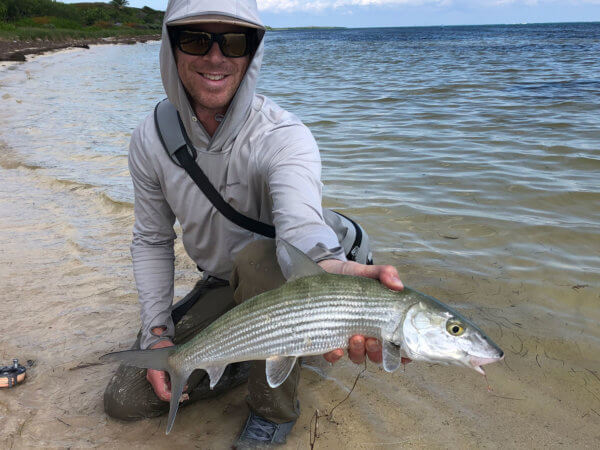 Sector 848-4
Sector 848-4
Troy: “While designed as a rod for the angler on the bow of a flats boat, I felt it was perfectly at home while wade fishing. I certainly had to focus on my back cast due to shorter length but this rod is probably one of my two favorites in the Sector lineup. Threw fairly large and heavy permit flies flawlessly, really fun.”
John: “I loved this rod for bonefish, both in and out of the boat. It swings lighter than any saltwater rod I’ve ever fished and shattered my assumption that a flats rod has to be 9’. It reminded me of the old Scott Heliply 8’8” rods, of which I still own a pair of 8-weights and a #11, but this rod swings much lighter with twice as much line speed and stability. It throws large shrimp just fine, but castability was limited when wading above my knees.”
Sector 909-4
Troy: “Had the opportunity to fish to both permit and bonefish with this rod. While a bit more than necessary for small bonefish flies in light wind, it still had the smooth action needed for shorter, accuracy-based shots. It is a fantastic permit rod for most applications although it did not respond great when casting really heavy, wind resistant crabs.”
John: “I couldn’t put this rod down. No matter how many times I cast, it never felt heavy. Paired with a Nautilus NVG 8/9, this was a combination I would recommend to anyone. I caught a really nice jack crevalle that went over 100 yards into the backing against a pretty stout drag. The rod has more butt section power than my Meridians without sacrificing one bit of casting touch at short distance. My favorite casting distance with the Sector 909-4 and a Rio DC Bonefish Taper was 50-80 feet. It’s an explosive caster.
Kris: Plain and simple? I just like it. Powerful enough to carry larger fly patterns and cut through wind but still a presentation-oriented rod design. I found myself reaching for it 5 out of 6 days and always felt ready for anything. The Sector 909-4 is a true workhorse saltwater fly rod.
Sector 8410-4
John: “I loved it from the boat, but didn’t fish it on my wading forays. I fished the 848-4 earlier in the week, loved it to death, but found it too short when I was belt deep, which was often. When fishing the 8410-4 with a heavy fly, it feels stubby unless the line has a short, heavy head. With shrimp, a Permit Taper or Tarpon Taper is ideal. With a crab, I would prefer an SA Grand Slam Taper or similar heavy-headed line.
Sector 9010-4
Troy: “This is my permit rod of choice. It handles the wind, heavy and wind resistant flies very well. Day 2 of panga fishing was probably the first time in my life that I had shot after shot at permit from 80-100 ft. My casting skills were put to the test with many failures but a few successes. The rod is very stable and allowed for repeated line pick ups with 50-70 feet of line on the water.”
Kris: Flats fishing for permit turns even the most experienced and stoic of anglers into temper tantrum throwing children. Casting distance becomes compromised, back casts are rushed and crab patterns inevitably wind up awkwardly stuck in the back of your buddy’s head. If you haven’t experienced it, at some point you will (and should). Subsequently, fly rod choice matters. A saltwater 10-weight must be accurate and it must be user friendly. It should feel light enough to cast all day, however, it has to be capable at distance and needs to allow the angler to pick up large amounts of line off the water for fast re-directed casts. I give you the Sector 9010-4.
More equipment comments
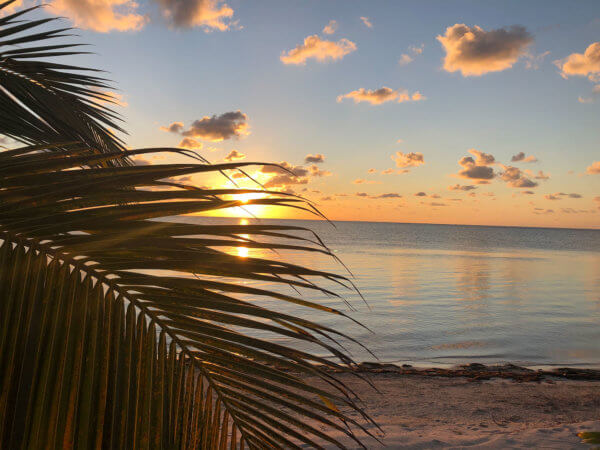 Waterproof packs were not just convenient. They were critical. In addition to delicious lunch sandwiches, they protected camera equipment and fly boxes while deep wading. They spent hours submerged or partly submerged over the course of our trip. I wore a Fishpond Thunderhead Roll-Top Backpack all week and wouldn’t consider going back without it.
Waterproof packs were not just convenient. They were critical. In addition to delicious lunch sandwiches, they protected camera equipment and fly boxes while deep wading. They spent hours submerged or partly submerged over the course of our trip. I wore a Fishpond Thunderhead Roll-Top Backpack all week and wouldn’t consider going back without it.- Fishpond Dakota case: how can you travel without a Fishpond Dakota case? This is the only piece of equipment that all four of us own. It’s designed for air travel, but we use them at home for organizing rods and reels all year long.
- Simms Flats Sneaker 2019: best in class, hands down. We walked at least 20 miles in these over the week over mixed bottoms and plenty of coral. All agreed that these were the most comfortable and suitable saltwater wading boots we had ever worn. You still need to take a liner sock and roll of gauze or electrician’s tape to prevent hot spots, but these boots are fantastic. Wading comfort is frequently a limiting factor on serious DIY trips.
- Fishpond Quickshot 2nd rod holders. The wisdom of this accessory goes out the window if you are wading deep, carrying a backpack or even fishing in moderate wind. The magnetic loop that secures the rod mid-blank is not powerful enough to prevent the rod from blowing free of its grasp. When things get exciting, your second rod may be at risk of swinging around in a rogue manner, risking breakage.
[Model-by-Model Sector Reviews]
[Scott Sector Fly Rod Pages]
[Saltwater Fly Fishing Gear Guide]